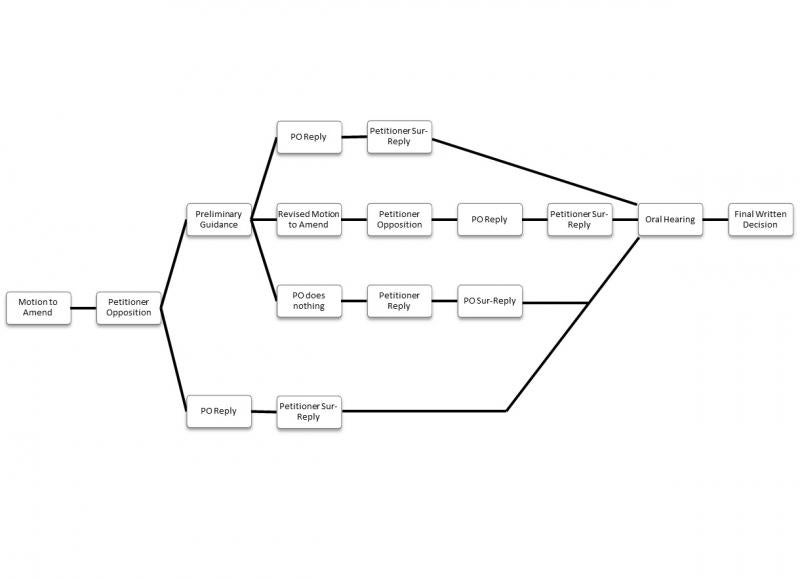In light of the many recent changes surrounding Post Grant Proceedings, below is an overview of the most recent changes and their potential impact to your business.
Overview
On March 15, 2019, the USPTO issued a notice announcing the Motion to Amend Pilot Program. The Pilot Program provides patent owners with two options:
(1) The patent owner may request to receive Preliminary Guidance (PG) from the Board on its Motion to Amend; and/or
(2) The patent owner may choose to file a Revised Motion to Amend after receiving the Petitioner’s Opposition to the original Motion to Amend and/or receiving the Board’s PG.
The Pilot Program is not retroactive; the Pilot Program only applies to cases that have been instituted on or after March 15, 2019. For cases that have been instituted prior to the effective date, the Board has noted that, if both parties agree, they may request the Board for permission to participate in the Pilot Program.
If the patent owner does not elect to participate in the Pilot Program, then the Motion to Amend practice will stay the same as the practice in the past, i.e., the parties will have a chance to brief the proposed substitute claims, but the Board will not issue a PG, nor will the patent owner be given the opportunity to file a Revised Motion to Amend after being served the Petitioner’s Opposition to the Motion to Amend.
A common question is whether, under the new Pilot Program, the original examiner will be involved in the Motion to Amend practice. The Board has advised that it is unlikely that an examiner will be involved. However, in the rare instance where the parties settle and the petitioner ceases to participate, the patent owner may request the Board to address the Motion to Amend. At that point, the Board may then solicit assistance from an examiner from the CRU but it is unlikely that the case would be routed to the original examiner.
The Board’s Preliminary Guidance
If the patent owner desires the Board’s Preliminary Guidance (PG), the patent owner must explicitly request it in the Motion to Amend. The Board’s PG is exactly how it sounds—it is a preliminary guidance on the proposed substitute claims and is non-binding. It will issue as a short paper, or in some cases as an oral guidance in a conference call at the Board’s discretion. The Board’s PG will assess whether there is a reasonable likelihood that the proposed substitute claims meet statutory and regulatory requirements, including whether there have been a reasonable number of substitute claims proposed (e.g., one-to-one) and whether the proposed substitute claims respond to a ground of unpatentability at issue in the trial.
The Board’s PG will not address patentability of original claims. The Board cautions parties from using Motion to Amend practice as means to brief issues relating solely to the original claims as a way to get the Board to provide an opinion on those claims before the Final Written Decision issues. Accordingly, the Board advises that the parties focus on arguments pertaining to how the amendments or additional limitations support patentability or unpatentability.
In cases where the Board issues a PG upon patent owner’s request, the patent owner may either choose to file a Reply to the Petitioner’s Opposition to the Motion to Amend and the Preliminary Guidance, file a Revised Motion to Amend (as discussed further below), or opt out of replying to the Petitioner’s Opposition to the Motion to Amend and the Preliminary Guidance.
Revised Motion to Amend
If the patent owner elects to file a Revised Motion to Amend, the Board will issue a Revised Scheduling Order to allow the parties an opportunity to brief the revised substitute claims. The Board has advised that even with a Revised Scheduling Order, they expect that they will still be able to issue a Final Written Decision within one year of the Institution Decision under the statutory mandate, absent a showing of good cause. On that note, the Revised Motion to Amend briefing period is expected to conclude approximately one week before the Oral Hearing.
In a Revised Motion to Amend, the claims must be responsive to the Board’s PG or to the Petitioner’s Opposition. The Board has cautioned patent owners from proposing amendments that are unrelated to issues raised in the Board’s PG or the Petitioner’s Opposition. Importantly, the Revised Motion to Amend is intended to be an opportunity for the patent owner to fix issues with the substitute claims raised in the Petitioner’s Opposition and/or the Board’s PG; it is not an opportunity for the patent owner to start from scratch.
Moreover, a Revised Motion to Amend should not incorporate by reference anything from the original Motion to Amend; the Revised Motion to Amend must be treated as a standalone document.
Comparison of the Motion to Amend paths
Below is a flowchart illustrating the various paths available in Motion to Amend practice.

Briefing Schedule under the Pilot Program
The figures below show the various timelines where the patent owner has requested the Board’s Preliminary Guidance on its Motion to Amend.
Option 1: After the Board’s Preliminary Guidance, the patent owner elects to file a Reply to the Petitioner’s Opposition to the Motion to Amend and the Board’s Preliminary Guidance

Option 2: Patent owner elects to file a Revised Motion to Amend in light of the Board’s Preliminary Guidance

Option 3: Patent owner opts out of replying to the Petitioner’s Opposition to the Motion to Amend and the Board’s Preliminary Guidance




 />i
/>i
